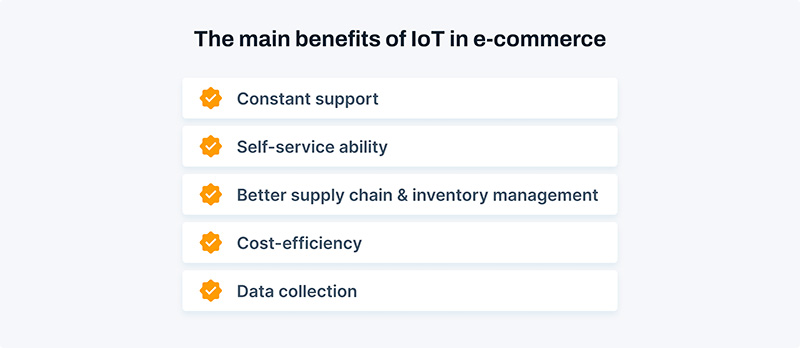Revolutionizing B2B: IoT in E-commerce Explained
February 22, 2024As IoT continues to proliferate across industries, its influence on B2B e-commerce is becoming increasingly profound. By seamlessly connecting physical objects to the digital realm, IoT is transforming the future of e-commerce to gather real-time data, automate processes, and create personalized customer experiences.
From inventory management and predictive analytics to supply chain optimization and smart logistics, IoT solutions are revolutionizing how B2B e-commerce transactions are conducted and managed. This article digs into the multifaceted impact of IoT in e-commerce, exploring its potential to reshape traditional business models and unlock new opportunities for growth and innovation.
IoT links devices through sensors and connectivity, allowing them to share data autonomously. This vast network offers significant benefits for e-commerce, transforming the business's function and interaction with customers.
The integration of IoT in e-commerce is expected to have a significant impact on the industry. The number of connected devices is expected to grow to approximately 27 billion connected IoT devices by 2025. IoT in e-commerce can benefit businesses by allowing the sale of "impossible" goods online, decreasing waste, improving maintenance, streamlining logistics, automating routine tasks, and gathering and analyzing data.
The adoption of IoT in e-commerce will increase significantly in the coming years as more businesses realize the potential benefits it offers.
What changes does the IoT bring to e-commerce?
Let’s discuss how the IoT is transforming the future of e-commerce.

Constant support
The e-commerce industry greatly benefits from the continuous support of the IoT. With IoT devices, businesses can enhance customer experiences, streamline operations, and spur growth. They track inventory, personalize marketing, ensure smooth payments, and manage logistics effectively.
As IoT technology advances, its impact on e-commerce will only expand, reshaping how businesses operate and connect with customers. IoT devices enable round-the-clock ordering, browsing, and customer communication. As millennials dominate B2B e-commerce purchasing, integrating seamless ordering processes tailored to their lifestyle enhances business success.
The B2B market has increasingly valued convenience, especially post-pandemic, witnessing a surge in digital purchases. About 80% of B2B buyers intend to continue with online transactions rather than returning to in-person sales post-lockdowns.
Self-service ability
The growing prominence of self-service IoT in e-commerce marks a significant shift in customer engagement and operational efficiency. With IoT-enabled devices, customers gain greater autonomy in accessing product information, placing orders, and managing transactions independently.
Increased self-service capability enhances customer satisfaction and streamlines business operations, reducing reliance on manual interventions and enabling round-the-clock service availability. As businesses embrace IoT technology, the potential for self-service experiences in e-commerce will expand by reshaping customer's interactions with brands and driving innovation in the industry.
Many B2B customers prefer digital self-service tools, like online portals or IoT devices, such as dash buttons linked to platforms. These buttons, strategically placed, let employees easily reorder supplies, like ink cartridges, when they run low.
Additionally, 80% of B2B buyers now anticipate a B2C-like ordering experience. Providing products via IoT devices, like voice assistants or mobile apps, mirrors the seamless purchasing journeys seen in everyday consumer life.
Enhanced supply chain and inventory management
IoT empowers businesses to adopt data-driven inventory management systems, leveraging sensors and real-time tracking technology. These systems monitor stock levels, anticipate replenishment needs, and prevent stockouts, ensuring products are available when customers need them.
IoT also optimizes supply chain processes, enhancing logistics, warehouse management, and order fulfillment for better efficiency, cost savings, and quicker deliveries. Integrated cyber-physical systems (CPS) efficiently manage inventory and alleviate supply chain bottlenecks by merging communication, computation, and control.
Through analyzing demand data and employing self-decision-making algorithms, machines streamline production with minimal human intervention, reducing errors and enhancing real-time interactions.
IoT is significantly useful in tracking and locating products, materials, and assets, as well as monitoring their status and environmental conditions. It suggests abundant opportunities for e-commerce businesses.
Cost-efficiency
As mentioned earlier, touchpoints and sensors provide continuous data to monitoring systems at various stages. It helps e-commerce businesses cut costs by improving communication between departments or warehouses, thereby minimizing or eliminating gaps.
IoT sensors can forecast potential operational issues with production line machinery. This enables proactive service, reduces downtime, and ensures equipment remains operational for longer periods.
Consider warehouses storing perishable goods, where maintaining consistent low temperatures is crucial. Temperature sensors instantly notify operators of any climate fluctuations, allowing prompt investigation to prevent stock spoilage.
McKinsey predicts that by 2025, IoT integrations like these could bring factories an annual value ranging from $1.2 to $3.7 trillion, emphasizing the significant impact of IoT on operational efficiency.
Data collection
IoT is transforming the future of e-commerce by gathering extensive data on customer behavior, preferences, and purchasing habits. Analyzing this data allows e-commerce platforms to conduct more accurate demand analysis, tailor personalized shopping experiences, and provide relevant product suggestions and promotions. This approach boosts customer engagement, fosters brand loyalty, and ultimately increases sales.
The impact of the IoT on businesses has been remarkable. By facilitating information sharing, the IoT enables firms to better understand customers and collaborate for improved demand planning and customer service. It effectively closes the information gap in modern supply chains by capturing detailed, real-time data across organizational entities, processes, and individuals.
By 2025, data collection via IoT devices is projected to soar to 73.1 zettabytes, a staggering 422% increase from 2019. When managed effectively, this influx of data provides valuable insights for B2B businesses.
Conclusion
In conclusion, the integration of IoT in e-commerce is transforming the landscape of online business, paving the way for innovative strategies and enhanced customer experiences. As IoT technologies continue to evolve, they will play an increasingly vital role in shaping the future of e-commerce, driving efficiency, personalization, and growth. Embracing these advancements will be crucial for businesses seeking to stay competitive and thrive in the ever-changing digital marketplace.
Do you run an e-commerce business? Are you wondering how you can integrate IoT solutions for business growth? Contact us to take your business to the next level.
